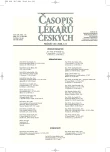-
Medical journals
- Career
Mitochondrial Neurogastrointestinal Encephalomyopathy (MNGIE)
Authors: T. Honzík 1; M. Tesařová 1; H. Hansíková 1; J. Krijt 2; P. Beneš 3; J. Zámečník 4; L. Wenchich 1; J. Zeman 1,2
Authors‘ workplace: Klinika dětského a dorostového lékařství 1. LF UK a VFN, Praha 1; Ústav dědičných poruch metabolismu 1. LF UK a VFN, Praha 2; Interní oddělení Nemocnice na Homolce, Praha 3; Ústav patologie a molekulární medicíny 2. LF UK a FN Motol, Praha 4
Published in: Čas. Lék. čes. 2006; 145: 665-670
Category: Case Report
Overview
Background.
Mitochondrial neurogastrointestinal encephalomyopathy (MNGIE) is a disorder with autosomal recessive inheritance caused by mutations in the gene encoding thymidine phosphorylase (TP). TP deficiency results in imbalance of mitochondrial pool of nucleotides leading secondary to multiple deletions and depletion of mitochondrial DNA (mtDNA) and impairment of oxidative phosphorylation system. The disease is clinically characterized by gastrointestinal dysmotility with symptoms of pseudo-obstruction, severe failure to thrive, ptosis, leukoencephalopathy, peripheral neuropathy and myopathy. We present results of the clinical, histochemical, biochemical and molecular analyses of the first Czech patient with MNGIE syndrome.Methods and Results.
Man, 33-years old with twenty-year history of failure to thrive (height 168 cm, weight 34 kg) and progressive gastrointestinal dysmotility, external ophthalmoplegia, leucoencephalopathy and peripheral neuropathy was recommended to metabolic center. Histochemical analyses in muscle biopsy showed the presence of „ragged red fibers“ with focal decrease of cytochrome c oxidase activity, but spectrophotometric analyses in isolated muscle mitochondria revealed normal activities of all respiratory chain complexes. Metabolic investigation revealed markedly increased plasma level of thymidine (6.6 μmol/l, controls <0.05 μmol/l) and deoxyuridine (15 μmol/l, controls <0.05 μmol/l). The activity of TP in isolated lymphocytes was low (0.02 μmol/hour/mg protein, reference range 0.78±0.18). Molecular analyses in muscle biopsy revealed multiple mtDNA deletions and homozygous mutation 1419G>A (Gly145Arg) was found in gene for TP. Both parents are heterozygotes.Conclusions.
MNGIE has to be considered in patients presenting with a combination of gastrointestinal and neurological symptoms. Plasma level of thymidine may serve as the best method for laboratory screening of MNGIE, but molecular analyses are necessary for genetic counselling and prenatal diagnosis in affected families.Key words:
MNGIE, gastrointestinal dysmotility, thymidine, thymidine phosphorylase, ECGF1.
Labels
Addictology Allergology and clinical immunology Angiology Audiology Clinical biochemistry Dermatology & STDs Paediatric gastroenterology Paediatric surgery Paediatric cardiology Paediatric neurology Paediatric ENT Paediatric psychiatry Paediatric rheumatology Diabetology Pharmacy Vascular surgery Pain management Dental Hygienist
Article was published inJournal of Czech Physicians

-
All articles in this issue
- Metamorphosis of Endocrinology
- Pancreatic Hormones and Hormonal Regulation of Insulin Secretion
- Regulation of Osteoclast Activity: A New Approach in the Therapy of Bone Diseases
- Spontaneous Pneumothorax
- EVI1 and Its Role in Myelodysplastic Syndrome, Myeloid Leukemia and Other Malignant Diseases
- Arterial Hypertension in Children and Adolescents
- Improved Control of Hypertension and Its Effect on Graft Function in Children After Renal Transplantation
- The Use of Nitric Oxide in the Treatment of Acute Respiratory Failure
- Auto- and Alloreactivity of T Lymphocytes in Myelodysplastic Syndrome
- Extent of Tuberculin Skin Testing Spot in Bacteriologically Verified Tuberculosis
- Improving Self-control in Substance Dependent Persons and Pathological Gamblers – A Pilot Study
- The Use of Photoprotection in Children of Prague Agglomeration
- Mitochondrial Neurogastrointestinal Encephalomyopathy (MNGIE)
- Meconium Ileus as a First Symptom of Cystic Fibrosis in a Newborn
- From the history of foster care
- Journal of Czech Physicians
- Journal archive
- Current issue
- Online only
- About the journal
Most read in this issue- Spontaneous Pneumothorax
- Meconium Ileus as a First Symptom of Cystic Fibrosis in a Newborn
- Extent of Tuberculin Skin Testing Spot in Bacteriologically Verified Tuberculosis
- Mitochondrial Neurogastrointestinal Encephalomyopathy (MNGIE)
Login#ADS_BOTTOM_SCRIPTS#Forgotten passwordEnter the email address that you registered with. We will send you instructions on how to set a new password.
- Career

